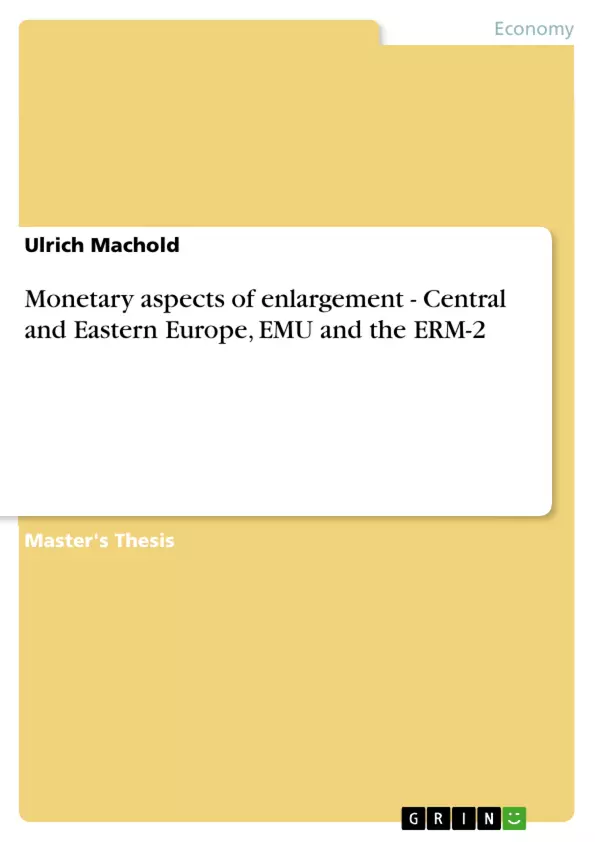A rough 50 years after its foundation, the European Union (EU) is preparing for the probably most ambitious challenge of its existence, the binding-back into the West of the once centrally-planned economies of Central and Eastern Europe (CEEC). Together with political and general economic efforts, European monetary integration also gains speed with as many as twelve CEEC queuing up for entry into the EU (not including Turkey, which has not yet officially begun entry negotiations), the first of them most likely joining the Union already two years after the physical introduction of the single currency, i.e. in 2004. Many of these countries are eager to also join Monetary Union (EMU) and show their ability to be ′good Europeans′ by adopting the Euro as soon as possible. Various statements by both CEEC-government officials and monetary authorities exemplify this very vividly.
This implies that the enlargement of EMU is already a relevant issue. By the time it becomes acute, positions and perspectives of both applicants and current members should be clear, if unnecessary delays and political irritations are to be avoided. The body of literature on the subject is thus as large as the questions of when, how and on what terms CEEC-accession will take place are pressing, and becoming more so as time progresses.
This study attempts to coherently examine the core issues related to EMU-enlargement, equally synthesising the various segmented approaches of the academic debate, and deduce normative conclusions as to what strategic outlook should seem appropriate to both CEEC and the current EMU-12: In what timeframe should accession most sensibly take place? How appropriate are the mechanics leading up to EMU, most prominently the Exchange Rate Mechanism (ERM-II) and the Maastricht criteria, and how should they be dealt with? What are the most likely problem areas and deficits that need to be confronted? Since there appears to exist a more or less stable consensus regarding the basic desirability of EMU for the CEEC, the paper will concentrate more on the run-up to full EMU, equally the road to the euro, and place special emphasis on the CEEC′s attitude towards the ERM-II.
Inhaltsverzeichnis (Table of Contents)
- 1. THE GROUNDWORKS
- 1.1 THE EMU-ACCESSION PROCEDURE
- 1.2 THE ERM-II
- 1.3 EXCHANGE RATE REGIMES IN THE CEEC
- 1.4 THE MACROECONOMIC SITUATION OF THE CEEC
- 1.5 EMU-ACCESSION STRATEGIES AND TIMEFRAMES
- 2. PHASE 2
- 2.1 A COMMON PROBLEM STRUCTURE - GOALS OF EXCHANGE RATE REGIMES IN TRANSITION COUNTRIES
- 2.2 WHICH EXCHANGE RATE REGIME FOR THE CEEC?
- 2.3 EXCURSE: CURRENCY CRISES
- 2.4 ADJUSTMENT CAPACITY
- 2.4.1 INSTITUTIONAL CAPABILITIES
- 2.4.2 FISCAL POLICY
- 2.5 WHICH ENTRY-RATE?
- 3. PHASE 3
- 3.1 IS AN ENLARGED EMU AN OPTIMUM CURRENCY AREA?
- 3.2 HOW FIT ARE THE CANDIDATES?
- 3.3 DO THE MAASTRICHT CRITERIA STILL MAKE SENSE?
- 3.4 PROBLEM AREAS AND POSSIBLE DANGERS
- 3.4.1 FISCAL DISCIPLINE AND PUBLIC INVESTMENT
- 3.4.2 “STABILITY CULTURE” AND THE ECB
- 3.4.3 DANGERS OF PREMATURE ENTRY
- 3.4.4 POLITICAL COSTS TO THE CEEC
Zielsetzung und Themenschwerpunkte (Objectives and Key Themes)
This study aims to analyze the core issues related to EMU enlargement, synthesizing the various perspectives within the academic debate and drawing normative conclusions for both the CEEC and the current EMU-12. It examines the appropriate timeframe for accession, the suitability of the ERM-II and Maastricht criteria, and the potential challenges that need to be addressed. The study primarily focuses on the run-up to full EMU, especially the transition to the euro, and emphasizes the CEEC's approach to the ERM-II.- The suitability of the ERM-II for the CEEC and the conditions under which they should join.
- The challenges and potential problems associated with the transition from the ERM-II to full EMU.
- The implications of EMU enlargement for the CEEC and the current members of the Eurozone.
- The importance of fiscal discipline, institutional capabilities, and exchange rate policies in the context of EMU accession.
- The potential risks and benefits of premature entry into EMU for the CEEC.
Zusammenfassung der Kapitel (Chapter Summaries)
- **Chapter 1: The Groundworks** This chapter provides a foundational understanding of the EMU accession process and the current situation of the CEEC in terms of their economic and structural preparedness. It examines the pre-accession phase, the accession stage, and the eventual transition to the euro.
- **Chapter 2: The CEEC and the ERM-II** This chapter analyzes the appropriateness of the ERM-II mechanism for the CEEC, exploring the conditions under which they should join and the potential benefits and challenges involved. It examines the goals of exchange rate regimes in transition countries, discusses currency crises, and examines the adjustment capacity of the CEEC, including institutional capabilities and fiscal policy.
- **Chapter 3: The CEEC and the Euro** This chapter delves into the transition from the ERM-II to full monetary integration, considering the implications for the CEEC and the Eurozone. It examines whether an enlarged EMU represents an optimal currency area, assesses the fitness of the CEEC for euro membership, and explores the relevance and effectiveness of the Maastricht criteria. Finally, the chapter discusses potential problem areas and dangers associated with premature entry into EMU, including issues related to fiscal discipline, public investment, stability culture, and political costs.
Schlüsselwörter (Keywords)
The core concepts and keywords of this study include: EMU enlargement, Central and Eastern European countries (CEEC), Exchange Rate Mechanism (ERM-II), euro adoption, Maastricht criteria, transition economies, currency crises, adjustment capacity, institutional capabilities, fiscal policy, and optimal currency area. The study focuses on the monetary and exchange rate aspects of the integration process, analyzing the challenges and opportunities for both the CEEC and the existing members of the Eurozone.- Quote paper
- Ulrich Machold (Author), 2002, Monetary aspects of enlargement - Central and Eastern Europe, EMU and the ERM-2, Munich, GRIN Verlag, https://www.grin.com/document/9451



